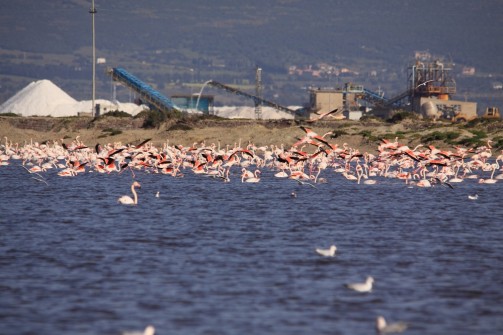The Salina di Sant’Antioco extends over a pericoastal strip about 20 km long, with a maximum depth of about 3 km. Constructed in the early 1960s through works to regulate and connect existing coastal lagoons, it went into production in the late 1960s. The useful area covered by water, which varies seasonally, is about 1,500 hectares, divided, into evaporating (1,300 hectares) and saline (200 hectares).
The productive function performed by the evaporating zones is mainly to bring seawater to saturation with respect to sodium chloride, providing for the increase from the characteristic density of seawater, 3.5° Baumè (Bè), to that of saturation, which is reached at a density of 25.7° Bè at a temperature of 15°C.The entire journey is accomplished by the water in 40-60 days depending on weather conditions. The remaining part of the sperface covered by water constitutes the saline zone, in which sodium chloride precipitation occurs.
This zone is continuously fed during the saliferous campaign with saturated water prepared in the evaporating zone, which here reaches densities close to 30° Bè. Continuous-cycle water movement is achieved by taking advantage of the natural gradient of the terrain for most of the surface; where this is not possible 6 hydro lift stations located in different areas of the Salt Marsh provide it. The most favorable period for production is from May to September: pumping operations begin when evaporation takes a clear upper hand over rainfall.
During the remainder of the year, production activity is aimed at preserving the characteristics of the water in the different evaporating zones. The characteristics of these very important sites, constitute an extraordinary habitat especially for the stopover and wintering of waders, spoonbills, cranes, great white egrets and small groups of geese, for habitual nesting birds such as the black-winged stilt, avocet, Kentish plover, little tern the tern tern, sea partridge, roseate and coral gulls, ducks of various species in addition to the famous pink flamingo, which, now consistently above a thousand individuals, represents in the salt marsh itself one of the most important European populations of this species.









